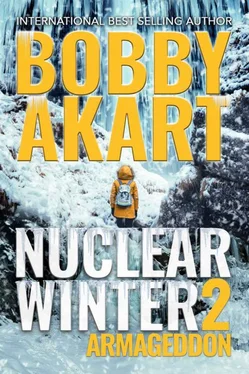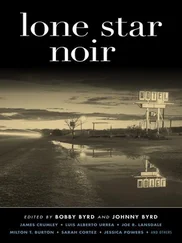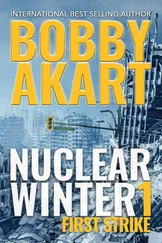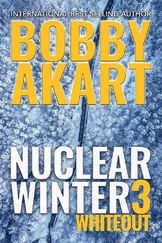However, as the skies continued to darken from the effects of nuclear winter, Hank was becoming concerned that the stackable lithium-ion batteries attached to the array might not hold their charges as the sunlight was blocked.
The batteries cycled daily, meaning they charged, drained and then recharged. Over time, the battery’s ability to hold a charge gradually decreased, eventually requiring replacement. The original batteries from seven years ago were now operating at seventy to eighty percent of their original capacity. The newer ones performed better. Like many things around the key, he wished he had more of everything Sol-Ark offered.
It was getting late, and he was becoming concerned about his brother. He made a mental note to have Mike secure a sheriff’s department radio for them. If not, he’d have the Monroe County Sheriff’s Department frequencies on their Bearcat scanners, another staple of boaters in the keys.
Hank was beginning to see why Phoebe had been in a frenzy throughout the day. They had to prepare for every possible contingency, including a permanent blackout. It helped Hank put his worries in the back of his mind. He tried to convince himself that he was preparing for the day Peter, Lacey and her family walked across the bridge leading to Driftwood Key. It was a vision he’d hold onto until that day arrived.
Saturday, October 26
Placer High School Fallout Shelter
Auburn, California
By day two in the fallout shelter, many of the occupants were beginning to notice that something seemed to be wrong with the ventilation system. First, the temperature, although not measured with any device, had risen dramatically. Everyone had stripped off unnecessary clothes and were still sweating. Those who were overweight suffered the most, coupling excessive perspiration with heavy breathing. This only served to make it warmer in the cramped space.
One of the benefits of placing a shelter deep into the ground was that dry earth was a reasonably good thermal insulator. The Placer High shelter was approximately thirty feet below ground. The walls were cool to the touch, although moisture had taken a toll in the past, and the paint was peeling off in many spots.
Large air ducts traversed the ceiling and then led upward through the ground or parts of the gymnasium. Round commercial air vents were located equidistant throughout the space, with one in each storage room and four in the main room. If you could reach these vents located twelve feet off the floor, you’d be unable to feel any air blowing through them.
There were no operable fans because the power grid was down. The only transfer of air was through the vents and provided via a Kearny air pump. Developed at the Oak Ridge National Laboratory in Tennessee when nuclear bunkers were first designed, the air pump system was designed to be operated by hand.
A filter was installed into an opening above the shelter on a swinging hinge. The design allowed the user to pull a rope to begin the swinging process. Air is sucked in from the outdoors and filtered of contaminants. It would then swing freely back, essentially creating a one-way valve that operated to force air to flow in only one direction.
When constructed, the fallout shelter at Placer functioned perfectly. Four nylon twenty-eight-foot-long pull cords were affixed to the Kearny air vents at the end of each duct. Minimal effort was needed to pull the cord and operate the pump, supplying a more than sufficient supply of fresh air to the shelter.
However, like everything else in this shelter, maintenance had been lax or nonexistent since the 1980s, and the rope cords had disintegrated over time. There was no fresh air flowing into the space. As a result, the carbon dioxide expelled from the occupants’ lungs remained mostly within the shelter, and the lack of oxygen resulted in their breathing becoming more labored.
After twenty-four hours, the effects were noticeable, and many became concerned. Especially when a heavyset man collapsed while sitting on the latrine with the door pulled down. He’d been inside the latrine for an inordinate amount of time. He’d entered the shelter alone, so there was no one familiar with the man or his health conditions.
At the time, there wasn’t anybody waiting their turn to use the latrine, so his presence in there for nearly fifteen minutes went unnoticed. Then a loud crash followed by a thud was heard by those sitting on the floor nearby.
A man jumped to his feet and began to pound on the corrugated steel door. This woke up everyone in the shelter, and soon the group was chattering excitedly. When there was no answer, he tried to pull up on the brass handle to open the door, but he was unsuccessful.
“Help me open this door!” he shouted to two men who stood nearby. They brusquely shoved their way past a woman and her three children, knocking them to the side. “It’s stuck.”
They slid their fingers into the groove of the door and, after a count of three, lifted it up until it rolled into itself. The man sitting on the latrine had passed out. He’d collapsed onto the floor with his pants around his ankles and his hefty body rolled up against the door. The latrine barrel he’d been sitting on had toppled over and spilled excrement on top of him.
It was a very undignified way to die, if dying could ever be considered dignified.
The police officer rushed to cover his dead body with a blanket. He used another towel to throw over the top of the urine and feces that covered the floor around the man.
People closest to the latrine immediately complained of the stench while others began to sob at the sight of the dead man. Some surmised the lack of fresh air must’ve triggered a heart or lung ailment. Regardless, the increasingly hot and stuffy shelter now smelled of sewerage and death.
People started to grumble again. Arguments broke out between one know-it-all and another. The coach was being pressured to let some people out who wanted to leave, but several people objected to that, as they were certain enough radiation would enter through the open doorway to kill them all or turn them into zombies.
Yes, zombies. A handful of people were firmly convinced that death by nuclear radiation would result in zombie-like creatures roaming the earth. When others countered that it was physically impossible for the dead to walk, the pro-zombie contingent countered that the planet had never been through nuclear Armageddon either, so nobody really knew for sure.
Oddly, the McDowells found the interaction between the other occupants of the shelter to be humorous. They made a game of labeling the most vocal among the group with nicknames from cartoon characters. With the zombie discussion, Walking Dead character names were being used to identify the other refugees.
The death of the man cast many in the shelter into a solemn yet sober mood. People had died in the nuclear blasts. For all they knew, the people locked out of the shelter the day before were lying dead in the stairwell. Suddenly, the cramped quarters and uncomfortable concrete floor didn’t seem so bad.
The conversations quieted down, and the man’s body was moved to one end of the latrine. It was surrounded by several empty meal boxes and water barrels to segregate it from those who had to do their business. However, several people made it known that his body would start to rot within twenty-four to seventy-two hours. As his internal organs began to decompose, his body would begin to leak fluids from all its orifices. It would stink and become a health hazard for everyone in the cramped space with no outside ventilation.
The coach and the police officer gathered in the corner of the storage room nearest the McDowells. They talked in hushed tones in an effort to prevent their discussion from being heard by the refugees.
Читать дальше












